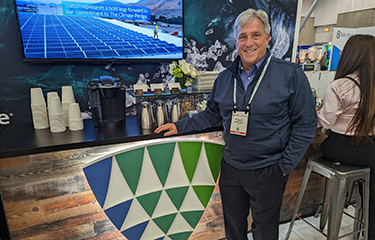US supply-chain situation improving, but still volatile

Almost exactly one year ago, Lineage Logistics Senior Vice President Brian Beattie painted a relatively grim picture of the state of cold storage from the perspective of the seafood industry: labor shortages, high energy costs, and abnormally high demand meant storage was both hard to find and came at a premium cost.
The story isn’t quite as grim as it once was, but Beattie told SeafoodSource during the 2023 Seafood Expo North America – running from 12 to 14 March in Boston, Massachusetts – that it isn’t a fairy tale either.
“The supply chain is still volatile, and it has not smoothed out, calmed down like it was five years ago,” Beattie said.
The demand and the delays aren’t quite as bad as they were in March 2021 – there are no longer backups of dozens of cargo ships outside of Los Angeles, for example – but throughput still hasn’t completely recovered and inventories are still at high levels, Beattie said.
“As we got into the fourth quarter and then the first quarter of this year, inventories continue to be stout, and it’s across the entire network,” Beattie said.
The “just-in-time” model of economics – which a panel at the Global Seafood Market conference said was dead – may not quite be completely buried yet, Beattie said, but it’s definitely on pause.
“Part of it is due to inventories being stout,” Beattie said. “If you have that mentality that, ‘I’m going to get back to just-in-time,’ will the rest of the supply chain be available to cooperate with your mindset? It has to be every step of the supply chain collaborating to make just-in-time work, and until there’s a much more smooth flow, I’m not sure we can get back to the just-in-time in the short-term.”
Beattie said supply-chain struggles did have some bright spots over the course of 2021. The industry as a whole, both on the logistics side and on the company side, has learned a lot from overcoming the many challenges of the past few years. Manufacturers, shippers, growers, and logistics and cold-storage companies like Lineage learned to collaborate on a new level to navigate around issues like the massive blockages at ports along the U.S. West Coast.
“It kind of pulled us all together – we had to figure it out,” Beattie said. “The collaboration that happened was, we all work together to figure out, ‘How do we redirect, how do we get through this,’ instead of everyone just digging in their heels and saying it’s a mess. The collaboration was at a level I’ve never dreamed of, and we were able to pivot, shift, and move things to ports in the South and in the East.”
Many companies began using cargo ports in other parts of the country, like Houston, Texas, which they never would have considered in the past. Diversifying ports has helped relieve bottlenecks, but Beattie said that it can only go so far, and capacity is still an ongoing problem in the cold-storage industry.
Lineage is working on building new facilities in areas where customers are demanding additional capacity. During the pandemic, customers were often having their products placed at any location that had available space, but now that the worst of the capacity issues are over, Lineage is working to get its clients’ products placed in facilities closer to their chosen destination.
“Let’s figure out the right place to build and go build,” Beattie said. “Our work today and over the next three years is, ‘Let’s build more capacity where our customers need it.’ It’s interesting [that] where production and inbound supply starts may not necessarily be where consumption is. So some of our customers at the front end of the supply chain want us to be near production where it’s grown, where it’s produced, and then other customers would like us to be where the consumption is.”
The new facilities, some of which are due to open soon, are evidence of the company’s focus on demand. A facility in ...
Photo by Chris Chase/SeafoodSource



Share